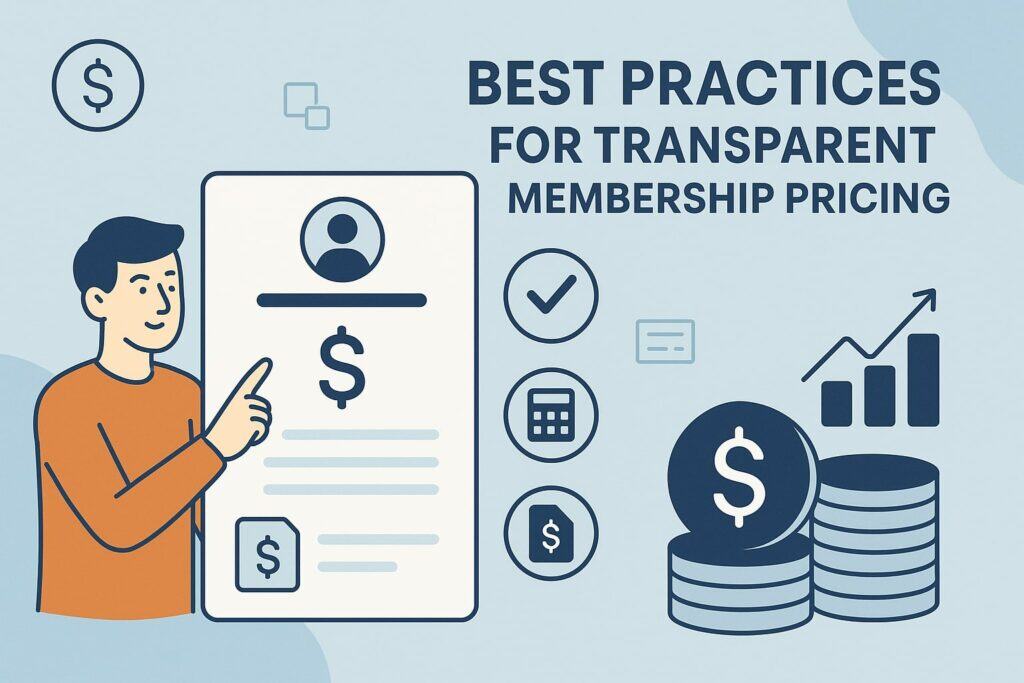
By alphacardprocess September 18, 2025
In recent years the membership economy has surged, reflecting a shift toward subscription and flat‑rate pricing models. Forbes projects that the global subscription market will reach $1.5 trillion by 2025, as businesses and consumers alike gravitate toward predictable pricing.
At the same time, there is growing consumer backlash against “hidden fees” – unexpected add‑on charges tacked onto bills for travel, shopping, finance, and more.
Membership payment programs (also called subscription or membership‑based pricing) address this problem by replacing variable surcharges with clear, upfront fees.
Under these models, customers pay a fixed membership fee for bundled benefits (such as free shipping, waived surcharges, or bundled services), which eliminates separate hidden charges at checkout.
This article explores how membership payment programs work, why they remove hidden fees, and how they are used in industries like retail, travel, fitness, and financial services.
The Hidden Fees Problem

“Hidden fees” (sometimes called junk fees) are extra charges not included in the advertised price of a product or service. They are often added late in checkout or buried in fine print.
Examples include airline baggage fees, hotel “resort fees,” restaurant service charges, credit card processing markups, or subscription auto‑renewal fees. These add-on costs frustrate customers and make price comparison difficult.
In 2023, the U.S. government took notice: President Biden convened private sector companies to commit to “all‑in pricing” that eliminates surprise fees and shows customers the full price upfront.
Likewise, regulators are moving to crack down on hidden charges – for instance, new Massachusetts rules (effective September 2025) prohibit any undisclosed fees on sales and auto‑renewing subscriptions. The upshot is clear: businesses are under pressure to practice transparent pricing.
Hidden fees also erode trust. Consumer advocacy reports highlight widespread “sneaky” charges in travel and commerce.
For example, after the President’s call to reduce junk fees, major ticketing and travel companies (e.g. Live Nation/Ticketmaster, Airbnb, SeatGeek) publicly promised to display final prices up front and remove add‑on charges.
The consumer finance benefit is concrete: Airbnb’s new “total price” tool shows all fees before taxes, and over 8 million guests have already used it to avoid surprises. In short, hidden fees are now seen as a pervasive problem across retail, travel, and digital services.
What Are Membership Payment Programs?

A membership payment program (or subscription-based pricing) is a model where customers pay a recurring fee in exchange for access to products or services – typically at discounted or bundled rates.
Unlike pay‑per‑use pricing, a membership program bundles costs into one predictable charge. In retail, this might be a warehouse club membership; in online services, a monthly subscription; in payments, a flat merchant fee.
For example, in credit card processing, “membership pricing” means the merchant pays a flat monthly membership fee plus a fixed per-transaction charge (and the required interchange fee), instead of a percentage markup on each sale.
In other words, the extra percentage that many processors tack on is removed. As merchant expert Erica Seppala explains, this model “cuts out the extra percentage markup most processors tack on to every sale,” effectively transforming payment processing into a wholesale‑club format.
More broadly, many subscription services operate on this principle. A gym membership might charge a flat $50/month for unlimited classes, rather than $10 per drop‑in class.
An e‑commerce subscription box charges one fee for a curated set of products, instead of charging each item separately. In financial services, “subscription payments” cover everything from premium accounts to loyalty clubs for a single fee.
Across these examples, the membership program acts like a club admission: pay once (monthly or yearly), and all or most extra charges are bundled or waived. This shifts pricing from unpredictable line‑item billing to a fixed, transparent rate.
How Membership Programs Eliminate Hidden Fees
Membership payment programs remove hidden fees through transparency and bundling. Key mechanisms include:
- All-Inclusive Pricing: By including what would normally be extra charges in the membership fee, businesses ensure no unexpected add‑ons.
For instance, payment processors with membership pricing bundle in gateway access, PCI compliance, monthly statements, and other fees that are usually extra.
As one merchant guide notes, “instead of separate charges for things like gateway access, statements, or PCI compliance, everything’s bundled into one subscription”. The result is a single predictable bill rather than a jumble of fees. - Transparent Rate Structure: Membership models advertise one flat rate or tier, making cost structures easy to understand. Companies often highlight “no hidden fees” in their marketing.
For example, Stax Payments emphasizes that its subscription plan is “paid in exchange for the direct cost of interchange” and stresses there are “absolutely no hidden fees” in its membership offerings.
Similarly, Clearly Payments (a merchant services firm) promises that a membership gives “direct access to wholesale costs” and boasts “No hidden fees or surprises”. These claims reflect the idea that nothing is tacked on later – the customer pays the listed fee and no more. - Flat Membership Fees: Since there is a fixed recurring fee, the incentive and practice of adding percentage‑based surcharges or transaction markups vanish.
For example, many gyms charge a fixed monthly dues and do not hit members with per-visit fees (or advertise any hidden administrative fees). Streaming services charge a set price per month instead of per video rental.
In merchant processing, the fixed monthly fee replaces all the small per-transaction percentage markups that used to inflate costs unexpectedly.
With this model, the customer or merchant simply pays the known subscription cost plus any legally required base charges (like interchange in credit cards), and no sneaky extra is applied. - Regulatory Compliance: Membership programs naturally align with new pricing laws. Because they commit all fees to the upfront membership price, businesses inherently comply with rules requiring full disclosure.
As UX experts emphasize, “transparent pricing” — showing “all costs, including renewal fees” up front — is key to building trust and loyalty.
By definition, a good membership model lists its fees clearly (often monthly or annually), meeting the spirit of regulations that ban undisclosed surcharges. - Predictable Budgeting: For customers, knowing the membership fee in advance means they can budget without surprises. Predictable costs minimize frustration.
Fintech firm Finli, for example, highlights that its subscription approach “eliminates the confusing, unpredictable variable fees” that come with transaction‑based pricing.
This reduces the chance of unexpected charges appearing on statements weeks later. In short, the uncertainty and hidden charges characteristic of traditional billing are replaced by a steady subscription price.
Industry Examples: Membership payment programs take many forms across sectors. Here are a few representative cases:
- Retail & E‑commerce: Online retail subscriptions (and even brick‑and‑mortar clubs) use membership fees to eliminate separate surcharges. Take Amazon Prime: for a single yearly or monthly fee, Prime members receive “free two-day shipping” and other delivery perks.
That means no additional shipping charge per order as long as the order meets the criteria. Prime even includes a free Grubhub+ subscription, which offers “unlimited $0 delivery fees” on food orders – again, bundling those delivery costs into the membership.
Warehouse clubs like Costco charge an annual membership but then sell goods at wholesale prices with transparent pricing, so shoppers face no surprise markups. (Real Simple notes that Costco members enjoy myriad discounts and benefits from bulk purchases to services.)
In e‑commerce broadly, subscription boxes (beauty, food, etc.) charge one flat fee for a curated assortment, removing any per-item or service fee. - Travel & Hospitality: Travel memberships often incorporate what would otherwise be extra charges. For example, airline loyalty programs essentially act as membership clubs: premium status or co‑branded credit cards can waive baggage fees and other add‑ons.
Delta Air Lines explicitly waives the first checked‑bag fee for its SkyMiles Medallion members – eliminating that common airline charge for card‑carrying travelers.
Hotel and rental membership clubs work similarly: paying a membership or loyalty fee often grants free cancellation or bundled perks (like complimentary breakfast, Wi‑Fi, or parking) that otherwise carry fees.
Travel subscription services (such as travel “clubs” or ticket pass products) charge a fixed price for a bundle of travel services, so members avoid paying individually for flights or hotel nights that might have hidden booking fees.
Overall, travel memberships simplify final prices – as the White House noted, ticketing platforms and venues are moving toward “all-in pricing” with no surprise fees. - Fitness & Entertainment: Many gyms, studios, and entertainment venues use membership models to eliminate per‑use charges. A monthly gym membership grants unlimited facility access and often includes classes, so members never pay per class or per-visit drop‑in fees.
Subscription fitness apps (like Peloton or ClassPass) charge one fee for all streamed workouts or classes. Likewise, digital entertainment services (Netflix, Spotify, etc.) charge a fixed subscription instead of pay-per-song or pay-per-show, removing ancillary charges entirely.
Even movie theater programs (annual passes) let cinephiles watch films for a single price, avoiding ticket surcharges on a per‑film basis. In each case, the membership fee covers what would otherwise be “pay-as-you-go” costs, so there are no hidden add-ons. - Financial Services & Payment Processing: In banking and payments, subscription pricing is becoming common. Fintech companies and merchant processors offer membership plans with no surprise fees.
For instance, a modern business banking platform advertises “no hidden fees or maintenance fees” on its subscription checking accounts.
Small‑business payment services like Finli and Stax emphasize transparent, all-in pricing: Finli’s COO explains that their model has “no hidden fees” and a simple subscription structure that replaces complex per-transaction costs.
Similarly, Stax notes that subscribing to its service means you only pay the interchange costs and a flat membership fee, ensuring “absolutely no hidden fees” on processing. For merchants, this model turns a complicated merchant statement into one predictable monthly invoice.
In short, whether it’s a retail club, a flight loyalty program, a gym, or a payment gateway, membership payment programs work by bundling or waiving incidental charges.
Customers pay the announced membership price and can trust that they won’t be hit by buried extra fees during use. Businesses benefit too: simpler billing builds trust and loyalty, and often unlocks steady revenue streams.
Best Practices for Transparent Membership Pricing

For a membership program to truly eliminate hidden fees, businesses must communicate clearly. Best-practice guidelines emphasize showing all costs upfront. UX research notes that subscription pages should include “transparent pricing” with all fees, including any renewal or cancellation charges, displayed up front to build trust.
In practice, this means listing the membership price and exactly what it covers (e.g. shipping, taxes, extra services), rather than hiding them on secondary pages. Companies often highlight trust signals – such as “no extra fees” guarantees – to reinforce clarity.
Internally, merchants considering membership pricing should bundle as many traditional fees into the subscription as feasible. For example, many membership‑based processors incorporate often-hidden charges like statement fees, gateway fees, and compliance fees into the flat plan.
They should also use short, month-to-month contracts without cancellation penalties (to avoid hidden cancellation fees). The Merchant Maverick guide points out that clear membership plans usually come “upfront about what’s included” and “won’t pile on surprise account fees”.
Likewise, ease of cancellation (e.g. cancel anytime) should be stated clearly to avoid “gotcha” cancellation penalties. By adhering to these transparent practices, businesses make the no-hidden-fee promise credible.
Challenges and Considerations
While membership models greatly reduce hidden fees, they aren’t a one-size-fits-all panacea. Businesses must ensure the membership fee is justified by value.
For very low‑volume or occasional customers, paying a flat membership fee might cost more than the usage fees they’d incur otherwise. Indeed, industry analysts warn that membership pricing is typically best for mid-sized or high-volume users – it can save money for large sellers but may be too expensive for very small merchants.
Consumers should similarly assess their usage: signing up for a club membership or subscription only pays off if they use enough of the included services (e.g. enough purchases to justify free shipping). If a member uses the service less than anticipated, they may end up paying a flat fee for benefits they don’t fully use.
Another consideration is that some incidental charges may still apply outside the membership scope. For instance, even with a membership pricing merchant account, chargeback fees and fraudulent charge costs often remain (since these are passed through at cost, not a percentage of sales).
Similarly, a gym membership might exclude certain premium services (like personal training or special classes) which could still carry extra fees. The key difference, however, is that these remaining charges are usually explicit and uncommon, rather than hidden in the fine print.
Moreover, companies must carefully calculate membership pricing to avoid unintended price hikes. Switching to a subscription model can be confusing if not explained well. Merchants often provide comparison scenarios to show how costs add up.
For example, payment processors illustrate scenarios showing large savings under membership pricing versus pay‑per-use plans. By making these comparisons transparent, businesses can reassure customers that no hidden catch is lurking – just straightforward, predictable billing.
Frequently Asked Questions
Q.1: What is a membership payment program?
Answer: A membership payment program (also called a subscription or membership pricing model) is one where the customer pays a fixed recurring fee (monthly or annual) instead of variable charges.
For example, in payment processing, the merchant pays a flat membership fee plus a small per-transaction fee (and just the standard interchange rate). In consumer markets, it’s like paying for a club membership or streaming service: one price covers most usage.
This replaces traditional billing models where many small charges and percentage markups could hide unexpected fees.
Q.2: How do membership programs eliminate hidden fees?
Answer: By consolidating costs into the membership fee, all common charges are included upfront. This means companies don’t tack on extra fees at checkout. For instance, some subscription services explicitly advertise “no hidden fees, no surprises”.
All costs (shipping, processing, etc.) are either waived or bundled. UX experts note that transparent subscription pricing builds trust, since “all costs… are clearly displayed and communicated upfront”.
In practice, this eliminates the common hidden charges (like service fees or processing markups) that customers would otherwise see later.
Q.3: Who benefits most from membership pricing?
Answer: Businesses or consumers with high or steady usage tend to benefit the most. For merchants, an analysis finds that mid‑sized and high‑volume businesses often save money with subscription‑style pricing, since it removes costly percentage fees. Very small or infrequent users might pay more under a membership plan than a pay-per-use plan.
Similarly, a consumer who shops frequently or uses many services will recoup a membership fee through bundled savings (free shipping, bundled services, etc.), whereas a light user might not. It’s important for each user to compare the membership cost against the value they expect to receive.
Q.4: Are there any fees not covered by memberships?
Answer: Most everyday fees are covered, but some incidents may still cost extra. For example, payment processors commonly still charge separately for chargebacks or certain compliance fees (because these costs are passed on at cost).
In membership subscriptions, unusual requests or add-ons outside the plan might incur charges (e.g. special classes in a gym). However, the key point is that all routine fees are disclosed up front. Unlike hidden fees, any additional costs under a membership program are typically noted in the terms and rarely occur under normal use.
Q.5: Do membership programs come with any hidden conditions?
Answer: Legitimate membership programs should have transparent terms. Consumers should look for clear descriptions of what is included and any conditions (such as minimum commitment periods or automatic renewals).
Best practices call for no fine-print surprises: all fees and cancellation policies should be upfront. Reputable providers will spell out everything in the membership agreement.
As long as businesses follow these transparency guidelines (and many now do in light of new regulations), there should be no hidden conditions. Always review the membership contract carefully before signing.
Q.6: Can membership pricing reduce overall costs?
Answer: Yes, often it can. Because memberships grant access to wholesale or discounted rates, they frequently lower total spending. For example, a merchant using a subscription‑based credit card processor pays only the direct interchange cost plus a low flat fee, which can be cheaper than a percentage‑based merchant account.
Likewise, a consumer paying once for unlimited shipping and streaming (as with many streaming services or online retailers) often spends less than if they were charged per item or per rental.
Businesses like Finli have shown that subscription billing can cut costs dramatically – one case study found over $700 per year saved for a typical small business by eliminating per‑transaction fees. In general, by removing hidden surcharges, membership pricing can lead to lower or at least more predictable bills.
Q.7: Are membership payment programs new?
Answer: The concept has old roots (e.g. magazine subscriptions or warehouse clubs) but has expanded greatly in the digital age. Today’s technology makes recurring billing easy to implement, so many new industries adopt subscription models.
As the Custom Travel Solutions report notes, travel companies and many others are “embracing the subscription economy” to build loyalty and revenue. With modern e‑commerce platforms and SaaS tools, any business can offer memberships or subscriptions.
What’s new is the scale: regulators and companies are now explicitly linking memberships to the elimination of hidden fees, making this model a mainstream best practice for transparent pricing.
Conclusion
Membership payment programs fundamentally increase pricing transparency by bundling costs into a single agreed fee. This model effectively eliminates hidden fees: customers know exactly what they will pay, and businesses collect revenue more predictably.
Whether it’s an online retailer offering free shipping to club members, an airline waiving baggage fees for loyalty members, a gym offering unlimited access, or a merchant payment provider offering flat processing plans, the pattern is the same.
All miscellaneous charges are covered by the membership, leaving no unknown extra charges at checkout. In an era where regulators and consumers demand upfront pricing, membership programs align perfectly with the mandate for honesty and simplicity.
For both consumers and businesses, the result is simple: fewer surprises, clearer accounting, and potentially lower overall costs.